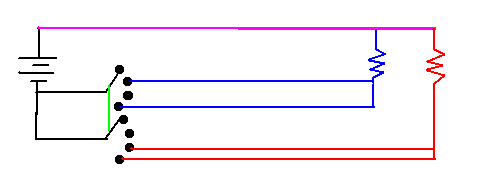
You have a floor lamp which can be dim, brighter, or really bright, depending on how many times you have clicked the switch. How does that work?
The light bulb has two filaments, as shown in the cut-away diagram below. These can be turned on in various combinations.
One way to
operate the light bulb would be to have two switches, that turn the two filaments on and off
independently. This would be just two parallel circuits.
You would have to turn both switches on to get the brightest light, and both off to turn the light
off; and to get from somewhat dim to really dim you would have to turn one switch off and the other
on.

The drawing indicates how the switch works. There is a sliding metal piece (the black rectangle) which can be in any of four places (where it is shown, or over one of the gray rectangles). It is connected to one of the wires from the power company. At each position there are two contacts (the black dots), and a wire from the light bulb might be connected to one of them. The black rectangle then powers up whichever of the filaments it is connected to in the position it is placed.

Here is a circuit diagram for the light bulb and its switch. The light bulb is represented by a pair of resistors.
The four position switch that is commonly used is a quadruple-throw double-pole switch (the quadruple-throw part just means that it has four positions, and the double-throw part means that at each position there are two circuits that are being made). In the diagram this is drawn as a pair of 4-position switches that are linked together. The red and blue wires control the two filaments; in the top position (where the switches are in the diagram) there are no connections and the light is off; as we move to the consecutive positions we get blue on, red on, and finally both red and blue on.
It's simple, and yet complicated to explain! There are similar switch arrangements in the control knob for the dishwasher and the clotheswasher. The car ignition switch, which lets you listen to the radio when the motor is not running, but won't turn on the air conditioner in that position, and then turns off the inside lights when you start the motor, could also be analyzed in terms of multiple-throw, multiple-pole switches.
Why study circuits?
The section on circuits